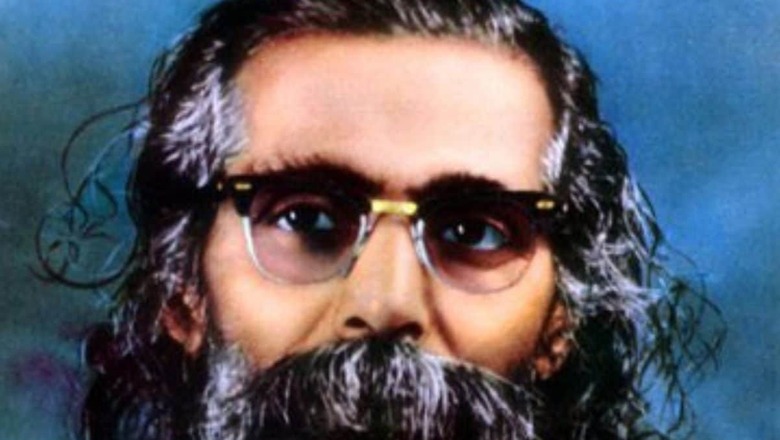
views
One of the most common argumentative sticks used to beat the Rashtriya Swayamsevak Sangh (RSS) by academia and anti-Hindu coalitions – at home and abroad – is its alleged role in Mahatma Gandhi’s assassination. It is repeatedly mentioned in research documents as well as commentaries by many academicians, especially in Europe and US, that the RSS was banned because of its involvement in the assassination of Gandhi.
Of late, several digital platforms have sprung up that are run by anti-Hindu coalitions. They, too, highlight the same argument. But what these academia and digital platforms tell you is only half the story. The real facts give you the full story that the RSS was not a perpetrator of a crime, but a victim. So let us take a look at some key facts about the Mahatma’s assassination and the ban on the RSS.
Gandhi was assassinated in New Delhi on January 30, 1948. The RSS, at that time, was headed by its second sarsanghchalak MS Golwalkar. The day Gandhi was assassinated, Golwalkar was in Chennai. As soon as he came to know of the shocking incident, he immediately passed instructions to all RSS shakhas.
“To express our grief due to the sad demise of respected Mahatmaji, shakhas will observe a condolence period for 13 days and all daily programmes will be put on hold,” the instructions stated.
In Delhi, meanwhile, the prant (state) sanghchalak Lala Hansraj Gupta and prant pracharak Vasantrao Oke went to Birla Bhavan and met many Congress leaders to express their grief and offer condolences.
Gandhi had spent his last 144 days in Birla Bhavan and that is where he was assassinated. It is stationed at Tees January Marg in New Delhi, which is now known as Gandhi Smriti.
A section of the Congress, however, was worried about the growing popularity of the RSS and saw an opportunity to finish off the organisation. The then prime minister, Jawaharlal Nehru, declared in Amritsar without having any evidence: “RSS is responsible for the murder of the Father of the Nation.”
‘Guruji’, as Golwalkar was popularly known, was arrested on February 2 and the RSS was banned on February 4, 1948, through a central government notification. The sarsanghchalak, while being arrested in Nagpur, said: “The cloud of suspicion will melt away and we shall come out of this unblemished. Until that time, there will be lots of atrocities but we should bear them with fortitude. I firmly believe that sangh swayamsevaks will pass this test successfully.”
He was sent to the Nagpur Central Jail. Dwarka Prasad Mishra, a veteran Congress leader who was the home minister of Central Provinces at that time, writes in his autobiography, Living in An Era: ‘That Mahatma Gandhi’s assassination gave a handle to unscrupulous politicians to defame and, if possible, to pull down their rivals is difficult to deny.’ (Page 59 of the original English version)
On January 30, 1948, at 5.45 pm, an FIR was filed in the Tughlaq Road police station in the New Delhi area. It starts with a brief statement from Nand Lal Mehta, a resident of Connaught Place in Delhi, as he was standing next to Gandhi.
“Today I was present at Birla House. Around 10 minutes past five in the evening, Mahatma Gandhi left his room in Birla House for the Prayer Ground. Sister Abha Gandhi and sister Sanno Gandhi were accompanying him.”
“Mahatma was walking with his hands on the shoulders of the two sisters. Two more girls were there in the group. I along with Lala Brij Kishan, a silver merchant, resident of No 1, Narendra Place, Parliament Street and Sardar Gurbachan Singh, resident of Timar Pur, Delhi, were also there. Apart from us, women from the Birla household and two-three members of the staff were also present. Having crossed the garden, Mahatma climbed the concrete steps towards the prayer place. People were standing on both the sides and approximately three feet of vacant space was left for the Mahatma to pass through. As per the custom the Mahatma greeted the people with folded hands.”
“He had barely covered six or seven steps when a person whose name I learnt later as Narayan Vinayak Godse, resident of Poona, stepped closer and fired three shots from a pistol at the Mahatma from barely 2/3 feet distance which hit the Mahatma in his stomach and chest and blood started flowing. Mahatma ji fell backwards, uttering ‘Ram Ram’. The assailant was apprehended on the spot with the weapon. The Mahatma was carried away in an unconscious state towards the residential unit of the Birla House where he passed away instantly and the police took away the assailant…”
Even as this FIR was being lodged on the evening of January 30, 1948, Golwalkar was attending a meeting of prominent citizens of Madras (as Chennai was known at that time). According to eyewitnesses, as tea was being served and Golwalkar was about to take the first sip, someone interrupted and broke the news about Gandhi’s death.
As soon as he heard the news, he put down his cup and a few moments later came his first spontaneous reaction in an anguished voice: “What a misfortune for the country!” After that, he immediately sent telegrams of condolences to Nehru, union home minister Sardar Vallabhbhai Patel and Devdas Gandhi, the fourth and youngest son of Mahatma Gandhi. He cancelled his nationwide tour and flew back to Nagpur.
After returning to Nagpur, the RSS sarsanghchalak wrote to Nehru: “The attack on such a deft helmsman who held so many diverse natures in a single string bringing them to the right path, is indeed a treacherous act not merely to an individual but to the whole country. No doubt you, that is the government authorities of the day, will deal suitably with that traitorous individual. But now is the testing time for all of us. The responsibility of safely steering the ship of our nation ahead in the present troubled times with an unruffled sense of judgement, sweetness of speech and single-minded devotion to the nation’s interest is upon all of us.”
In another letter sent separately to Sardar Patel, Golwalkar wrote: “Let us shoulder the responsibility that has fallen upon us by the untimely passing away of that great unifier, keeping alive the sacred memories of that soul who had tied diverse natures in a single bond and was leading them all on a single path. And let us, with the right feelings, restrained tone and fraternal love, conserve our strength and cement the national life with everlasting oneness.”
After the RSS was banned as Nehru tried to finish the organisation, Golwalkar was ironically arrested under the notorious Bengal State Prisoner’s Act. Nehru himself had condemned this act before independence as a “black law”.
The RSS sarsanghchalak was released six months later. In fact, not even a single chargesheet was filed against any swayamsevak (volunteer). The ban on the RSS was lifted on July 12, 1949.
A month after Gandhi’s assassination, Sardar Patel wrote to Nehru: “I have kept myself almost in daily touch with the progress of the investigations regarding Bapu’s assassination case. All the main accused have given long and detailed statements of their activities. It also clearly emerges from the statements that the RSS was not involved in it at all.”
Patel in another letter to Golwalkar said: “Only the people near me know as to how happy I was when the ban on the Sangh was lifted. I wish you all the best.”
In 1966, the Congress government headed by then prime minister Indira Gandhi again set up a new judicial commission to thoroughly probe the assassination of Gandhi. Justice JL Kapur, a retired judge of the Supreme Court, headed it. The commission examined 101 witnesses and 407 documents and published its reports in 1969. Its key findings were:
‘They (the accused) have not been proved to have been members of the RSS, nor has that organization been shown to have had a hand in the murder.’ (vol. I, p. 186)
‘There is no evidence that the RSS as such was indulging in violent activities against Mahatma Gandhi or the top Congress leaders.’ (vol. I. p. 66)
One of the most important witnesses who deposed before the Kapur Commission was an Indian civil services officer RN Banerjee, who was the union home secretary at the time of Gandhi’s assassination.
Banerjee told the Kapur Commission that even if the RSS had been banned earlier, it would not have affected the conspirators or the course of events “because they have not been proved to have been members of the RSS nor has that organisation been shown to have a hand in the murder”.
The ban on the RSS was finally lifted at midnight on July 11, 1949. Guruji was released on July 13, 1949, from Baitul prison. He went straight to Nagpur from there. During the ban, the government had confiscated the RSS headquarters Dr Hedgewar Bhavan. It was given back to the RSS on July 17, 1949.
The RSS shakha at Mohite Ground started the next day. Guruji, while addressing swayamsevaks, said: “Our work is beginning again today. A person waking up from sleep feels refreshed and energetic. We, too, have to start our work with the same enthusiasm.”
(The writer, an author and columnist, has written two books on the RSS. He tweets @ArunAnandLive. Views expressed are personal)
Read all the Latest Opinions here
















Comments
0 comment